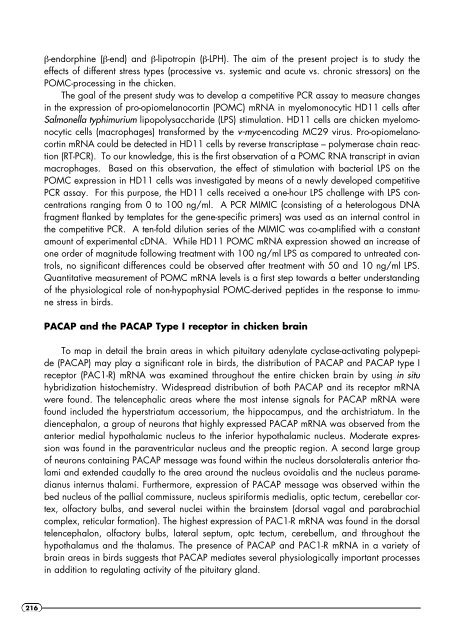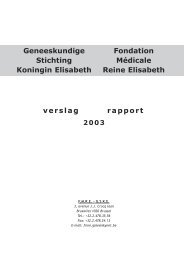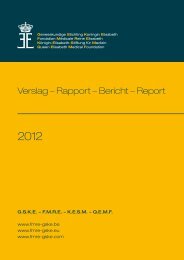Geneeskundige Stichting Koningin Elisabeth ... - GSKE - FMRE
Geneeskundige Stichting Koningin Elisabeth ... - GSKE - FMRE
Geneeskundige Stichting Koningin Elisabeth ... - GSKE - FMRE
Create successful ePaper yourself
Turn your PDF publications into a flip-book with our unique Google optimized e-Paper software.
216<br />
β-endorphine (β-end) and β-lipotropin (β-LPH). The aim of the present project is to study the<br />
effects of different stress types (processive vs. systemic and acute vs. chronic stressors) on the<br />
POMC-processing in the chicken.<br />
The goal of the present study was to develop a competitive PCR assay to measure changes<br />
in the expression of pro-opiomelanocortin (POMC) mRNA in myelomonocytic HD11 cells after<br />
Salmonella typhimurium lipopolysaccharide (LPS) stimulation. HD11 cells are chicken myelomonocytic<br />
cells (macrophages) transformed by the v-myc-encoding MC29 virus. Pro-opiomelanocortin<br />
mRNA could be detected in HD11 cells by reverse transcriptase – polymerase chain reaction<br />
(RT-PCR). To our knowledge, this is the first observation of a POMC RNA transcript in avian<br />
macrophages. Based on this observation, the effect of stimulation with bacterial LPS on the<br />
POMC expression in HD11 cells was investigated by means of a newly developed competitive<br />
PCR assay. For this purpose, the HD11 cells received a one-hour LPS challenge with LPS concentrations<br />
ranging from 0 to 100 ng/ml. A PCR MIMIC (consisting of a heterologous DNA<br />
fragment flanked by templates for the gene-specific primers) was used as an internal control in<br />
the competitive PCR. A ten-fold dilution series of the MIMIC was co-amplified with a constant<br />
amount of experimental cDNA. While HD11 POMC mRNA expression showed an increase of<br />
one order of magnitude following treatment with 100 ng/ml LPS as compared to untreated controls,<br />
no significant differences could be observed after treatment with 50 and 10 ng/ml LPS.<br />
Quantitative measurement of POMC mRNA levels is a first step towards a better understanding<br />
of the physiological role of non-hypophysial POMC-derived peptides in the response to immune<br />
stress in birds.<br />
PACAP and the PACAP Type I receptor in chicken brain<br />
To map in detail the brain areas in which pituitary adenylate cyclase-activating polypepide<br />
(PACAP) may play a significant role in birds, the distribution of PACAP and PACAP type I<br />
receptor (PAC1-R) mRNA was examined throughout the entire chicken brain by using in situ<br />
hybridization histochemistry. Widespread distribution of both PACAP and its receptor mRNA<br />
were found. The telencephalic areas where the most intense signals for PACAP mRNA were<br />
found included the hyperstriatum accessorium, the hippocampus, and the archistriatum. In the<br />
diencephalon, a group of neurons that highly expressed PACAP mRNA was observed from the<br />
anterior medial hypothalamic nucleus to the inferior hypothalamic nucleus. Moderate expression<br />
was found in the paraventricular nucleus and the preoptic region. A second large group<br />
of neurons containing PACAP message was found within the nucleus dorsolateralis anterior thalami<br />
and extended caudally to the area around the nucleus ovoidalis and the nucleus paramedianus<br />
internus thalami. Furthermore, expression of PACAP message was observed within the<br />
bed nucleus of the pallial commissure, nucleus spiriformis medialis, optic tectum, cerebellar cortex,<br />
olfactory bulbs, and several nuclei within the brainstem (dorsal vagal and parabrachial<br />
complex, reticular formation). The highest expression of PAC1-R mRNA was found in the dorsal<br />
telencephalon, olfactory bulbs, lateral septum, optc tectum, cerebellum, and throughout the<br />
hypothalamus and the thalamus. The presence of PACAP and PAC1-R mRNA in a variety of<br />
brain areas in birds suggests that PACAP mediates several physiologically important processes<br />
in addition to regulating activity of the pituitary gland.
















